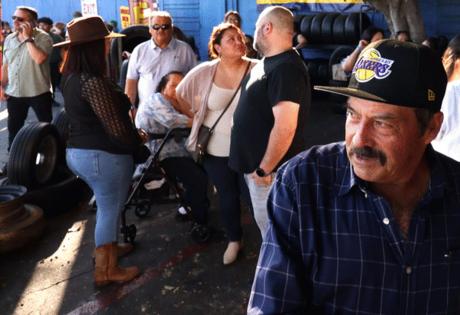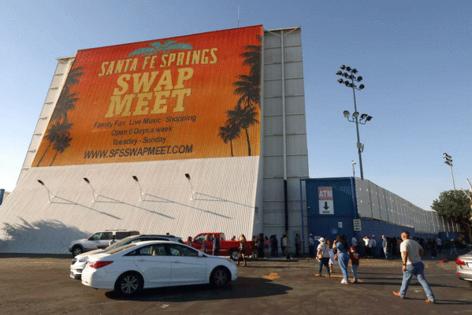What social media got wrong about the ICE raids of the Santa Fe Springs Swap Meet
Published in News & Features
SANTA FE SPRINGS, Calif. -- The beer was flowing and the scent of churros and Mexican food hung in the air as Mexican bandas performed at the Santa Fe Springs Swap Meet.
“All the women who think men are useless, let me hear you,” the singer of Banda Valle Verde Del Pacifico shouted into the microphone. A wave of screams and laughs filled the venue as people bounced and twirled to the popular Mexican music.
On this recent Saturday afternoon, more than 3,000 people enjoyed the festivities, the largest turnout since nearly 100 federal immigration agents raided the predominantly Latino shopping center in June.
But the boisterous gathering represented a break from recent trends at the swap meet. Since the raid, the crowds have shrunk and some vendors have abandoned the location, fearful of another immigration action.
“Ever since these [raids] started, it’s been a sad scene,” said Juan Romano, 76, who waited two hours in the scorching heat to attend the concert. “I feel for those [vendors] who sell, who are trying to make a living.”
The June 14 operation sparked public outrage against the federal government, the swap meet owners and the city. Immigrant rights activists accused the swap meet of failing to stop the agents from entering the grounds and not alerting vendors and customers, giving the appearance that they cooperated with immigration officials. Some called for a boycott of the shopping center.
The result has been a drop in patrons and the loss of about 66 of its 306 vendors, which has forced a reduction in staffing from 111 employees to 67. The raid came as the swap meet — along with many others — struggles to recover from the COVID pandemic, the growing popularity of e-commerce and rising inflation. The operators have gone so far as to drop rental fees to keep from losing more vendors.
But much of the fury that followed the raid was fueled by speculation and rumors that spread through social media. The posts included videos and news reports describing the operation as chaotic, hours long and suggested that dozens of vendors and customers may have been detained, including some who were dragged out of bathrooms. Some posts claimed the Marines and National Guard took part in the raid.
But swap meet owners said none of that happened and the misinformation created a false narrative that eroded the public’s trust and worsened the economic hardship experienced by the business and its vendors.
In a statement, swap meet officials said the open-air shopping center has long been a cultural hub for Latinos but was “unfairly caught in the optics of a federal show of force.”
Three days before the June 14 raids, swap meet officials said they emailed managers, who oversaw staff and vendors, and provided them instructions on how to respond if ICE agents showed up. But a review of the memos and protocols show that officials expected a targeted operation, not a mass federal raid with agents armed with assault rifles in tactical gear.
Since then, swap meet officials said they’ve taken additional steps to address the public’s safety concerns, and are trying to restore trust with the vendors and patrons by addressing speculations and rumors.
‘Out of our control’
In a written statement to The Times, a spokesperson for the Department of Homeland Security confirmed that agents with Immigration and Customs Enforcement and Customs and Border Protection were at the swap meet that day. They said two Colombian nationals were arrested for being in the country illegally and identified them as Jose Torres-Avellaneda and Laura Magaly Rodriguez-Gelvez.
“Both of these illegal aliens have been previously arrested for illegal entry,” the agency’s statement read. “Torres-Avellaneda remains in custody pending removal. Rodriguez-Gelvez was granted a voluntary departure and was removed from our country in August.”
But the spokesperson did not respond to further inquiries to provide details about the operation.
Three days after the incident, the U.S. Border Patrol uploaded a video of the raid on its Instagram page for what appears to be promotional purposes. Federal immigration officials would do the same the following month with an immigration action in MacArthur Park.
Also angering some patrons were videos on social media that seemed to show swap meet patrons grilling managers about their response to the raid, suggesting they didn’t do enough to keep the agents out.
Shortly after the raid, swap meet officials issued a statement on Instagram to address the public’s concern.
“To be clear, the Santa Fe Springs Swap Meet, and its personnel did not coordinate with ICE or participate in any preplanning of immigration enforcement with federal officials,” swap meet officials said in the statement. “These actions were completely out of our control.”
Their statement, however, was met with more backlash.
‘Far from mass detentions’
The Times reviewed more than a dozen video clips taken by the swap meet’s security cameras that day. The clips show five masked agents approaching one of three entrances at 3:52 p.m. An employee is seen briefly speaking with an agent, who pauses to respond before entering, prompting the employee to follow along. The video has no sound so it’s unknown what the worker told the agents, but legal experts say federal agents can generally enter public spaces without a warrant or permission.
Swap meet officials said workers were told by the agents that they were there to check on people’s IDs. A reporter embedded with the agents said they were looking into allegations that people were “selling goods illegally,” but that it was foiled after people were tipped off.
Officials said workers and customers had already spotted the agents that morning, and news of their presence began to circulate on social media.
About a minute after entering the swap meet, the videos show the five agents returning to the same entrance, known as Box 1, where about 20 masked agents are standing around before they all make their way in as well. At the same time, at another entrance known as Box 3, about 70 agents make their way in.
Dozens of video clips show the agents strolling throughout the shopping center, followed by swap meet employees who were observing and recording the agents. The videos show the agents stopping people at random and making hand gestures as if they’re asking for IDs. People are seen showing them identification cards before walking away.
The videos also capture the moment agents arrest the two Colombian nationals. They also show agents talking to two separate vendors. It’s unclear whether they spoke to other vendors that day.
The operation prompted officials to cancel a Father’s Day Mexican music concert that was scheduled to begin at 6 p.m. that day. Nearly 4,000 tickets had been sold for the event. The company would cancel five other concerts in the weeks following the raid out of concern for the community.
Swap meet officials acknowledge there was some lapse in following the guidelines they established three days before the raids. A Times review of those protocols, which were created on June 6 and finalized on June 11, instructed workers to notify the general manager about the presence of law enforcement.
The workers were told to ask for a copy of a judicial warrant if federal agents sought to enter the property.
“At the same time, we emphasized the importance of not resisting lawful identification to avoid any risk of obstruction,” swap meet officials said in their statement.
They said staff notified management when they first spotted federal agents outside the center that morning, but management took no action because it did not appear initially that the agents were staging an operation, and had eventually left the area.
When agents returned to enter the grounds hours later, staff did not appear to warn vendors or customers as they were instructed to do. But by then, swap meet officials said the shopping center had closed for the day and there were only a few vendors and customers still inside.
“The raid itself was brief, limited in scope and yielded only two arrests — far from the rumors of mass detentions,” the officials said in their statement.
‘It comes down to expectation of privacy’
A major criticism of swap meet officials has been that it appeared that they didn’t stop the agents from entering the grounds, but legal experts say federal agents have leeway to enter public spaces.
“I think it comes down to the expectation of privacy, so if the public can access a location, then federal enforcement agents can go there,” said Jean Reisz, co-director of the USC Gould School of Law Immigration Clinic. “And they can start asking people questions, but those individuals should be free to not answer questions and walk away.”
But, she said, if there are areas that are not accessible to the public, such as a break room for employees or the cashier area, then that would not be accessible to enforcement agents unless they had a warrant or were granted access by the person in control of those areas.
“Anyone can go into a shop so there’s not a big expectation of privacy there, but not everyone can go into the backroom where there’s a break room, conference rooms or storage where customers are not allowed,” she said.
Swap meet officials said they’ve learned from the experience and have taken extra steps to protect patrons and vendors. They have hosted a “know your rights” workshop, similar to the one they hosted at their location in Nevada, which was conducted by the ACLU of Nevada.
“This training is vital. Everyone should be empowered with accurate information so they can be confident in any interaction, even being pulled over for a traffic ticket,” said David Gonzalez from the Hispanic Outreach Taskforce, who ran the workshop. “From the 50 people that attended, one woman was very impassioned about the topic, and asked why more people didn’t show up.”
Swap meet officials said they’ve also placed bilingual posters throughout the grounds and distributed red cards to inform the public of their constitutional rights. Taking it a step further, they said they’re working on a text alert system that would be used to notify patrons when federal agents show up.
It’s unclear if the changes put in place will turn around the fortunes of the swap meet. But several vendors said they remain committed.
For 50-year-old Rosa Tlatelba, a vendor who sells customized T-shirts and sweaters, leaving Santa Fe Springs is not an option she has considered.
“My grandmother started selling here about 40 years ago,” she said. “I have clients who came here with their parents. Now, they come here with their kids and ask about her.”
Amid a declining clientele, Tlatelba said Santa Fe Springs is still “the most flexible place to sell,” adding that she tried out the Cyprus and Paramount swap meets, but she ultimately found her current spot the best place to sell.
A vendor who declined to be identified out of fear of the government said they depend on the swap meet to make a living, driving more than 40 miles from Riverside to sell electronic accessories.
“We had [the pandemic], but honestly, this is the worst. I’m scared of being here,” the vendor said.
Tlatelba said the future of the swap meet comes down to everyone succeeding.
“I was unhappy with how management handled [the raid],” she said. “But I just want this to succeed for everyone. I want to work with [management] and get things better because if they succeed we succeed.”
©2025 Los Angeles Times. Visit at latimes.com. Distributed by Tribune Content Agency, LLC.














Comments